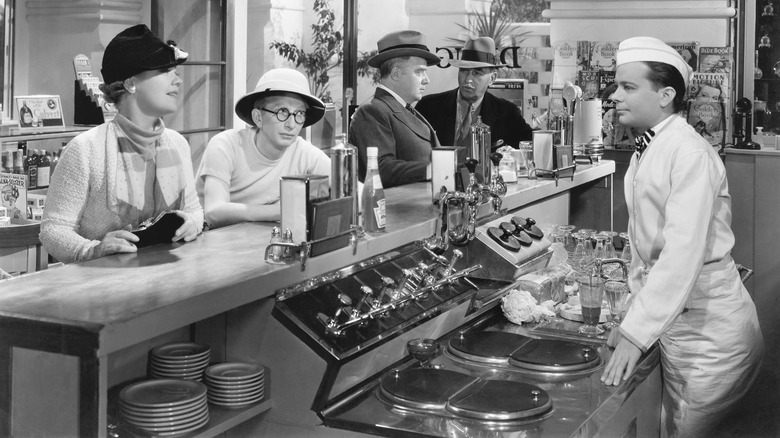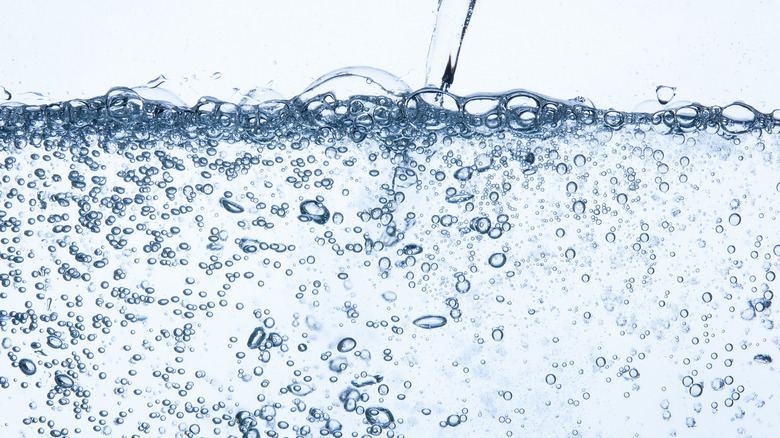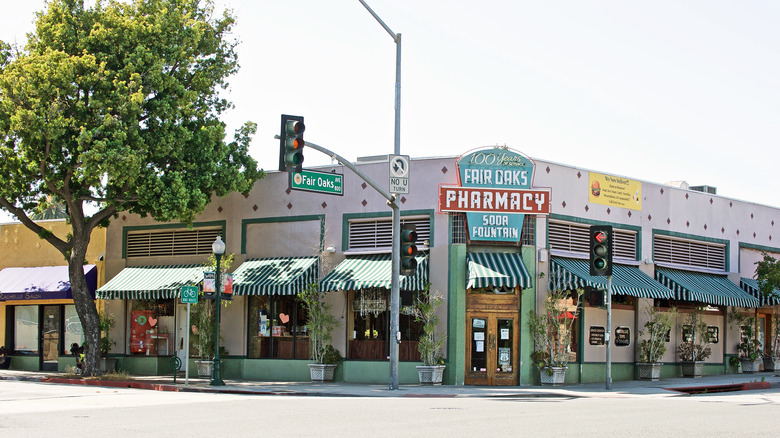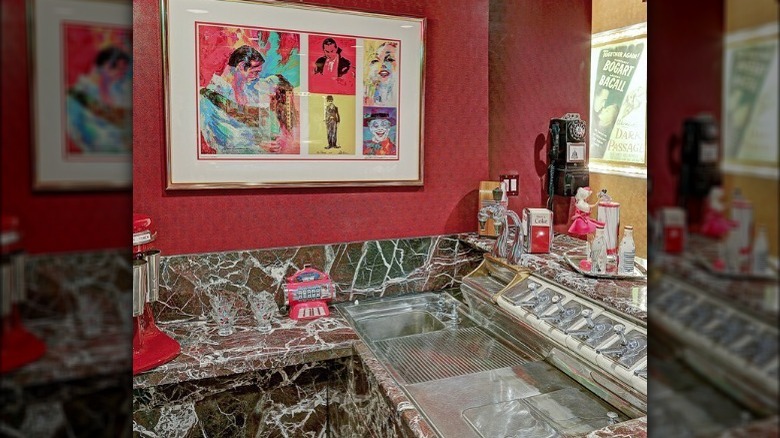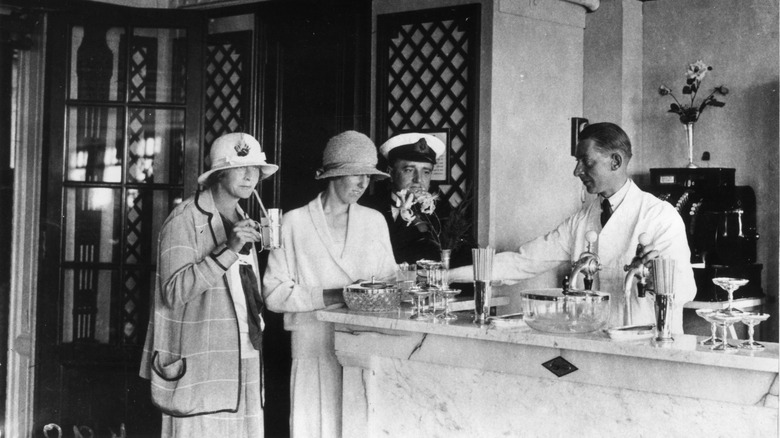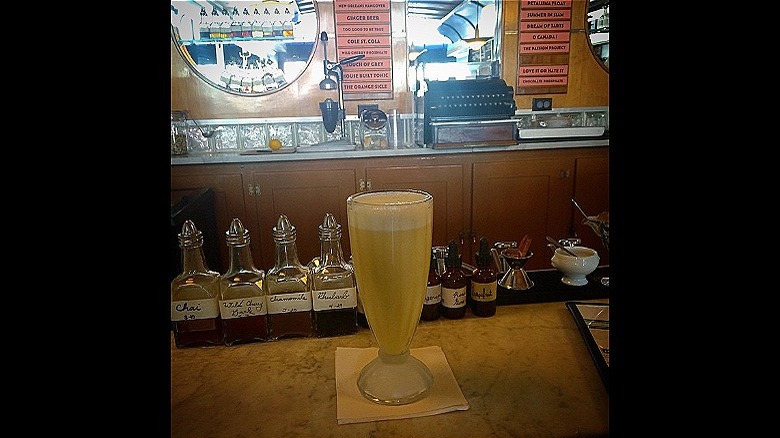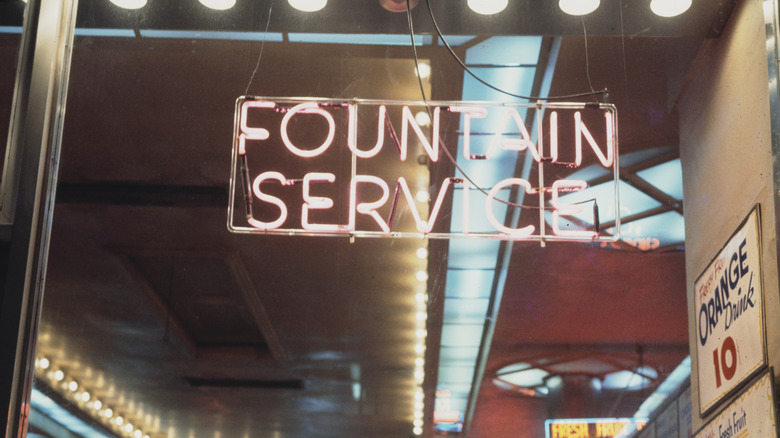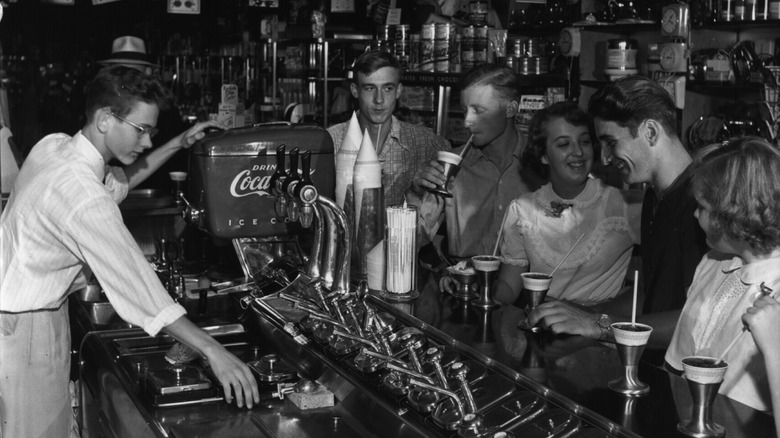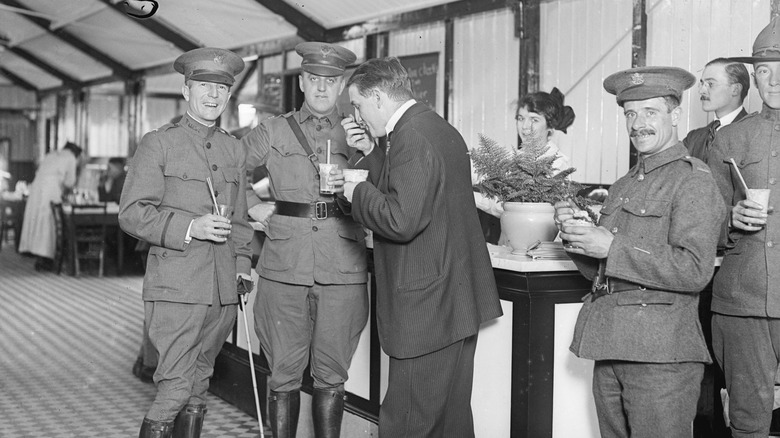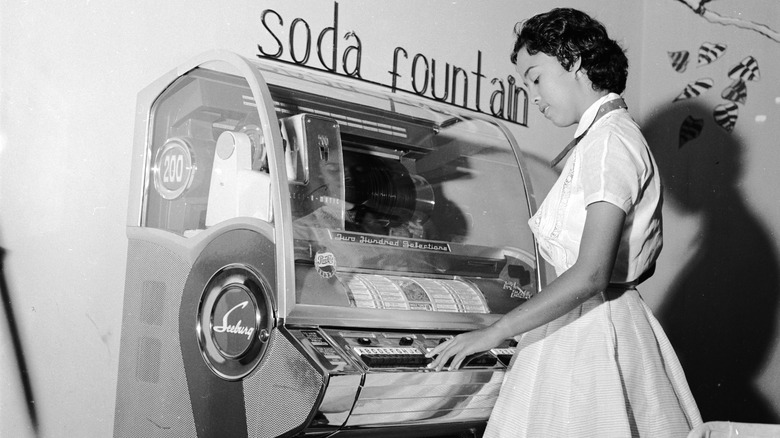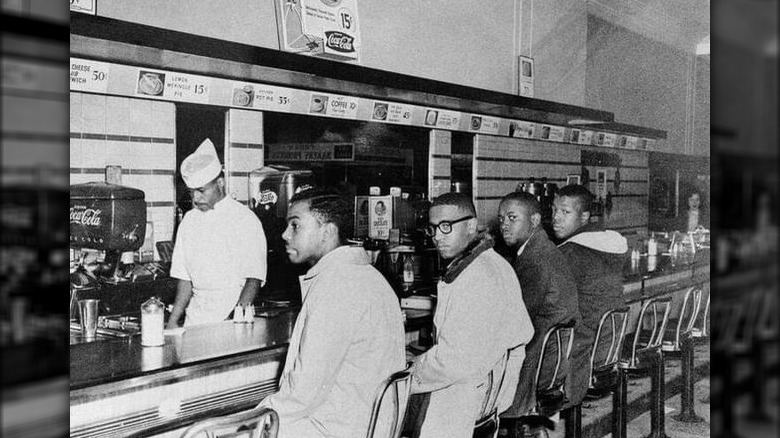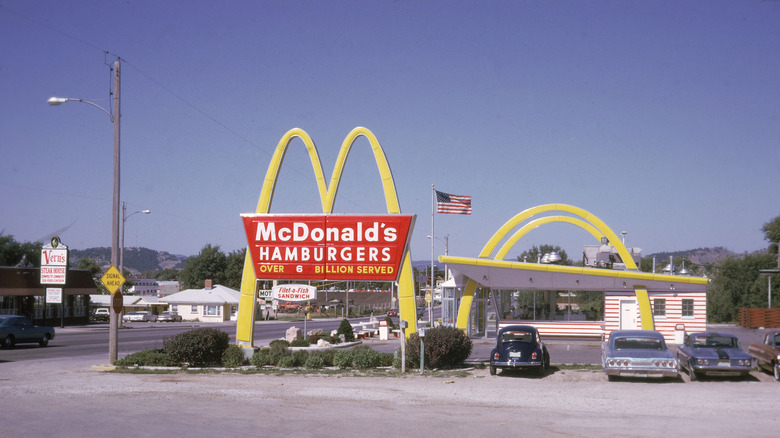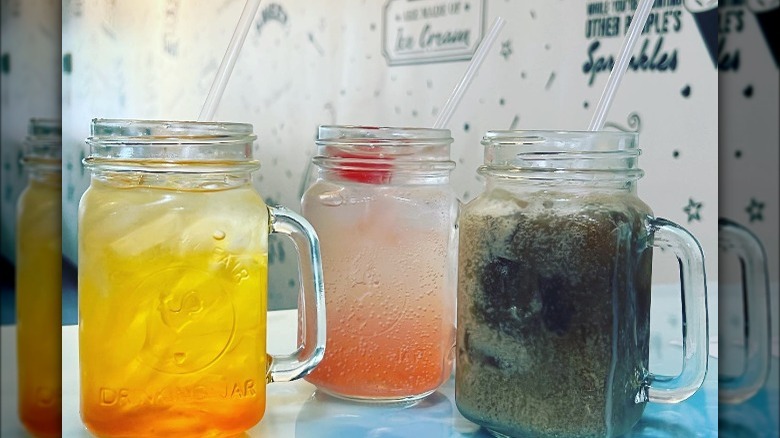What Going To An Old-Fashioned Soda Fountain Was Really Like
"Put your head on my shoulder," or as the song by Paul Anka goes. Just the phrase "soda fountain" evokes a pristine image for many: checkered floors, leather-upholstered booths, and couples lovingly staring into each other's eyes as they lean forward and sip from the same milkshake, with two straws of course. Greasers hit the jukebox and girls in poodle skirts flounce past strong-armed men rattling drink orders in a tumbler. Everything is in black and white for some reason.
Those born after the 70s may never have been to one of these All-American classics, but most likely have seen them on screen. Soda fountains were a huge part of the American culinary scene and are still often reflected in the media; "Pleasantville," "That '70s Show," and "Scooby-Doo" are only some shows that center soda fountains as the group hangout place. Despite their lack of relevance in contemporary society, these establishments were around for a very long time, and the history behind them may be surprising. Often, the food served is just a part of the story. In any case, it's worthwhile getting to know this cultural institution.
Soda was invented in the 18th century
Soda is so ever-present that it's hard to imagine there was ever a time when there wasn't easy access to it. But once upon a time, soda wasn't just a rarity, it didn't exist. To have soda, there has to be seltzer, otherwise known as soda water. Sparkling water has a long history in the Old World, where it can even be traced back to naturally occurring springs in Italy (via Italy Magazine). Romans would gladly visit these bubbling oases as they held the belief that the water had curative and restorative properties. Babbel also cites health and hygienic concerns as a major reason for the proliferation of sparkling water, especially in the form of bottled water.
The U.S. hopped on the bubbly bandwagon much later. It wasn't until around the mid-18th century that techniques were developed to make man-made seltzer, primarily by adding acid and chalk (via Bundaberg). Though, with a few hiccups along the way, eventually the soda fountain machine was made to produce soda water. The machines were capable of infusing pure water with bicarbonate to create soda water, as detailed by How Stuff Works. Ever erring toward the sweet and indulgent, it is unclear who first mixed fruit syrup with soda water, but what is clear is that this was the beginning of a very beautiful friendship in the late 18th century. Soda, the American concoction, had been birthed, and it was here to stay.
Soda fountains were once linked to drug shops
There was a certain symbiotic relationship between soda fountains and pharmacies at first. Soda fountains were large and cumbersome machines that demanded a lot of room to roam. Meanwhile, in the early 18th century, it was not uncommon for people to turn toward drugs to cure their ailments, given that America was undergoing one of its first drug booms. The medicine at the time was often quite bitter, but, when paired with say a bubbly drink that's been flavored with a masking sweet flavor, it suddenly became all the more palatable (via NPR). Pharmacies and soda fountains went together hand in hand. Pharmacy Times posits that the soda fountain was an extension of the pharmacy and considered to be just as much of a cure-all; the soda was, in effect, the medicine.
It's a bit more understandable when taking a step back and looking closer at the ingredients list why this was. Sodas were simply made differently in the mid-19th century. Of course, cocaine-infused Coke is an infamous and almost joke-worthy example. But, at one point not long ago, it was truly believed to be a valid cure and served over the counter, often for headache relief, as explained by Medical Bag. Caffeine was heralded as a miracle drug and treated similarly. Naturally, patients would frequently have to come back regularly to treat their headaches. But that's another discussion altogether.
There was an aesthetic aspect to soda fountains
Besides putting a pep in the proverbial step, there was an aesthetic element to these machines that was meant to replicate naturally harvested mineral water. Before electric cooling, soda fountains relied on other cooling methods to keep the water fresh, whether by means of large blocks of ice, brine, or ammonia (via the University of South Carolina and ThoughtCo).
Soda fountains in the 19th and 20th centuries weren't like anything that could be found in McDonald's today. This partially explains why soda fountains were so large — their counter-like set-up also allowed for socializing and sipping. Maybe it was partially their size that allowed for so much design play-room. Vintage soda fountains, like the Liquid Carbonic Company Soda Fountain, for example, were nothing short of an elegant affair (via Drugstore Museum).
ThoughtCo described the design influence on soda fountains as varied; some drew influence from Baroque design elements while others, known as "Transcendent," featured Greek-derived stars and statues. Some even took a more statuesque approach. These elegant behemoths were made out of marble and sometimes topped with small sculptures and Tiffany lamps to add an indulgent twist to the entire experience (via Roots Soda Company). Often, the aesthetic experience of the soda fountain was just as much a part of the appeal as the soda.
Soda fountains became their own unique locale
From their first introduction in the 19th century until the 1950s, soda fountains came into their own. No longer was it necessary to go to an apothecary, pharmacy, or the like to indulge in a fizzy drink. Soda fountains became their own establishments, destination, and drink, as observed by Dusty Old Thing.
Sodas becoming their own drink has to do a bit with the evolution of drinking culture in the 20th century. During this period, there was a shift away from narcotics and a push for temperance as a whole. But a major contribution to the shift from pharmaceutical drug to recreational drink was in part due to a more surprising source: legislation (via History Network). The Harrison Narcotics Act of 1914 was one of the first major pieces of legislation that completely illegalized opium products and their use and distribution. After that came the birth, however unintentionally, of the modern soda. No longer was soda necessary to cure headaches or viewed as medicinal, it became its own item on the menu and a gastronomical delight.
Another political event pushed soda fountains further into the mainstream: Prohibition. In the 1920s, the distribution, sale, and use of alcohol were effectively banned. As many folks suddenly lost bars and nightclubs as their social spaces, they turned to soda fountains to meet their social drinking needs. Suddenly, there was a new space to meet up with friends, find love, and simply unwind.
Sodas back then differed from today's sodas
The Harrison Narcotics Act of 1914 and the growing independence of soda fountains led to a shift in the flavor composition of fountain drinks. As cocaine, cola, and other narcotics were removed from the ingredients list, the drinks grew increasingly less pharmaceutical in taste. In the 19th century, along with the previously mentioned narcotics, bromides, phosphates, and a host of other tastes were often one and the same with soda.
Newspapers.com noted that the 19th century saw the rise of other drink formulas at the soda fountain. Egg was a very popular ingredient used to make a creamier drink. According to the website, egg phosphates were a particular darling on the menu. The drink combined soda water, raw egg, phosphate, and flavored syrup to make the magic. Around this time, malt milkshakes were popularized as well and consisted quite literally of shaken milk with ice, flavoring, and, at times, raw egg (via Art of Drink).
By the 20th century, sodas continued to evolve. The originally less-sweet mixed drinks changed to much more recognizable delights like the strawberry flip and orange fizz, as per Atlas Obscura. Notably sweeter drinks, like the malt milkshake, also began to pick up steam. Soda fountain drinks went in an entirely new direction: they were served warm. These drinks were intended to attract clients during the cooler months when soda fountains would remain less visited.
Soda fountains were largely an urban experience
Some of the first soda shops in the 19th century were opened in major cities like New York and Atlanta, and this didn't change throughout the century, as per How Stuff Works. The previously mentioned Roots Soda Company went so far as to describe soda fountains as the "life and soul of American urban culture." It can easily be assumed that soda shops provided an oasis during the otherwise busy week for those who lived there. On the operator's side, soda fountains were much cheaper to run than other types of eateries as well. Even throughout the 19th and 20th centuries as soda fountains began to open across Europe, America remained the unchallenged capital of all things sweet.
The infrastructure of the United States had changed by the mid-century, and cars became increasingly available to more citizens. With increased private transportation, among a myriad of reasons, once-urban inhabitants turned their eyes toward the suburbs. With their flight, so too moved the soda fountain, at least partially. No longer were soda fountains a highly centralized experience; however, the decentralized experience of the suburbs spelled out a challenge for the once urbanite soda shops (via Saint Louis Magazine). A notable exception is that in the Midwest, which was more or less "dry," the soda fountain held a special place as a social gathering place, as outlined by Dusty Old Thing.
Soda fountains became a prime teen hang-out spot
Soda fountains were always social spaces where people went to relax and enjoy. As mentioned above, the Prohibition years allowed for soda fountains to flourish. The alcohol ban did not last for long in the United States, and people soon flocked back to the bar. While some adults still swung by the soda fountain for the odd malt or milkshake and food, there was another demographic that took the soda fountain by storm: teenagers (via Roots Soda Company).
Of course, teenagers don't have legal access to drinking. The soda fountain, thus, offered a place of refuge that was neither home nor school for this major marketing demographic. It was, in short, the quintessential hangout spot. In an article from The Wall Street Journal, one malt shop regular said that, at least in her case, the soda fountain was a place "to see and be seen." The article even described the soda fountain as the "Woodstock of the '50s" — a place where teenagers from all different walks of life could come together under one roof and over one drink. Even for some workers, also known as soda jerks, the soda fountain was not only a place of employment but a community contact point. In an interview with the Akron Beacon Journal, one such soda jerk went so far as to buy the soda fountain counter from his youth and recreate the atmosphere in his neighborhood.
By World War II, soda fountains began to fade out
Not everything was peachy for the soda fountains — there were still specific challenges that increasingly affected the once-hyper trendy space. The world wars, for one, were troubling times, where food rations, specifically involving sugar, chocolate, and vanilla, proved to be especially detrimental to the business (via The National World War II Museum). After World War I, a specific soda tax, meant to help pay off debt, began leeching off the once-lively locals. Depending on the perspective, Prohibition and even World War II thankfully saw a turn back toward non-alcoholic beverages. So prevalent was soda to the American soldiers that it was included in war rations. Soda acted not only as a sweet reprise from the brutalities of war but as a symbol of the American way of life.
Nonetheless, the conclusion of World War II presented even more new challenges for the soda fountain, albeit culturally. The preceding boom years spelled out luxury for some Americans, and the diner and cinema grew in popularity as preferred places of indulgence. As alcohol became more readily available, adults of legal age once more turned back to the bar for providing their socializing needs. With more people working, newly emerging fast-food restaurants began popping up and offering lunch on the go. These factors, however, did not spell the end for the soda fountains ... yet.
The mid-century was iconic for soda fountains
Despite the many increasing challenges to the soda fountain establishment, the mid-20th century was an iconic era. Furniture designer Heywood-Wakefield noted that soda fountains of this time really came into their iconic look. So iconic, in fact, that soda fountains still endure as a fixture of the 50s, even though one could argue that the soda fountain's real heyday was much earlier in the 20s or 30s.
Though soda fountains were once ostentatious feats of elegant Baroque design, by the mid-century, the soda countertop had become much more streamlined. The fountain itself turned toward a stainless steel or marble flat-top, where patrons could still sit more casually at the counter should they wish. Soda shop fixtures were most likely the biggest change to the soda shop, where checkered floors, leather booths, and decorations worked to set the soda fountain apart from others.
As competition increased between and against soda fountains, there were a few other tweaks in the 50s to encourage patronage. One major new addition might be unexpected: rock 'n roll and jukeboxes (via Off the Leash). As teenagers and kids became the main diners, there was a push to encourage them to stay a little while longer and listen to music. It could be that this was the only place for some to listen to music, while the rock 'n roll likely made the soda shop an edgier place to spend time.
Soda fountains were not open to everyone
Despite their social leanings, soda fountains certainly weren't open to everyone. They even became a major part of the Civil Rights Movement. Malt shops were often operated along the lines of segregation, and it was common for would-be black patrons to be denied service in white-only soda fountains (via Points). While it remains unclear if there were specific soda fountains that served the black community, what is clear is that the soda fountains became a point of contention in the fight for civil rights. Lawsuits had long been filed against soda fountains for denied service to black customers, though these were for the most part ineffective and largely unsuccessful.
In the face of this, these social spaces came to function as a location for protests as well. As noted by the African American Intellectual Historical Society, one of the first boycotts actually happened in the late 40s and was pushed by Edna Griffin, who was refused service on the basis of her skin color. For two months, she orchestrated sit-ins, boycotts, and protests. This eventually brought her to court, where the jury sided with her and awarded her a minuscule $1 in damages. Nonetheless, her lawyer viewed this as a "moral victory." Protests, boycotts, and sit-ins occurred at various soda fountains for a good 10 years as the Civil Rights Movement progressed.
Soda fountains went into sharp decline by the 1960s
Despite the soda fountains' widespread presence throughout the mid-century, by the 60s and 70s, soda shops began to lose major cultural relevance and all but disappeared from the American culinary scene, as per ThoughtCo. The previously mentioned Roots article pointed the finger at the major fast-food boom as one of the fatal developments for the soda fountain. With the increased popularity (and lowered price point) of fast-food chains, soda fountains faced a major competitor that was hard to keep up with. What's more is that the once main demographic of soda fountains, teenagers, began to flock to fast-food chains (via Museum of Youth Culture). Additionally, a new soda fountain was developed that was much smaller, faster, and cheaper than the original soda fountain, which fast-food chains began to implement in their establishments.
To add to the death of a thousand cuts, refrigeration and the general availability of ice cream contributed heavily to the loss of soda fountain novelty (via The Chronicle). Soda fountains became more of a nostalgic rarity rather than a place people visited regularly. How the mighty do indeed fall. But, when it's all said and done, well over 100 years of relevance and longevity isn't a failure. As with everything with a cutting edge, so, too, it must at some point dull.
A come-back in the making
Fashion exists in cycles and perhaps food does too. Nearly 50 years after the fact, it could be that soda fountains may be on the upswing again. NPR noted as early as 2011 that the revival of soda fountains could fall in line with other consumer trends like organic, small-batch, and local. One could even infer a demand for unique and artisanal goods.
In parts of the States that are home to many non-drinkers, soda remains a cornerstone in drinking culture. In fact, Michigan Daily, perhaps dubiously, asserts that soda fountains never lost popularity in what is referred to as the Mormon Corridor. Drinks like the dirty soda, a startlingly sweet mix of diet coke, half-and-half, and coconut syrup have even recently blown up on the Internet, specifically on TikTok (via The Washington Post). Even outside of the viral nonalcoholic soda cocktails, soda chains are springing up in the region with gusto, as observed by The New York Times.
As millennials continue to drink less and less alcohol, and while most of Gen Z still hasn't reached drinking age yet, perhaps soda chains and soda shops are on their way back in a way that exceeds simple nostalgic value. While The New York Times observes a major dip in daily American soda consumption, it may still be high time for the unique soda. The soda fountain may really be on its way back — after all, it has proved to be more than adaptable more than once.
